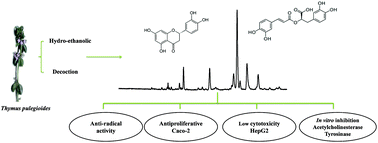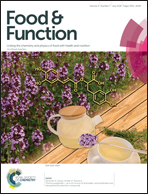Thymus pulegioides L. as a rich source of antioxidant, anti-proliferative and neuroprotective phenolic compounds†
Abstract
The potential of Thymus pulegioides L. as an alternative and valuable source of functional ingredients has been assessed. For this purpose, the phenolic constituent profiles and the antioxidant, anti-proliferative, neuroprotective, anti-aging and anti-diabetic activities of both T. pulegioides aqueous decoctions (AD) and hydro-ethanolic extracts (HE) were studied and compared for the first time. Rosmarinic acid was the main phenolic compound, accounting for 35.2% or 47.8% of total identified phenols in AD or HE, respectively (58.5 and 151.9 mg g−1 extract). Furthermore, large amounts of luteolin-O-hexuronide (AD: 39.9 ± 2.5 mg g−1, HE: 60.8 ± 7.0 mg g−1), eriodictyol-O-hexuronide (AD: 19.9 ± 2.5 mg g−1, HE: 26.8 ± 7.0 mg g−1) and chrysoeriol hexoside (AD: 23.5 ± 0.7 mg g−1, HE: 16.0 ± 0.7 mg g−1) were found. Both extracts showed significant in vitro antioxidant activity and anti-proliferative activity against Caco-2 cells (IC50 82.25 μg mL−1 and 105.44 μg mL−1, AD and HE, respectively), and reduced hepatotoxicity (HepG2 cells). In general, both T. pulegioides extracts showed poor anti-diabetic activity, moderate anti-aging effects and high neuroprotective activity with both AD and HE extracts, at 0.5 mg mL−1, showing 80% inhibition of the acetylcholinesterase activity and 94% inhibition of the tyrosinase activity. The present study highlights the important potential of this herb as a functional food ingredient.



 Please wait while we load your content...
Please wait while we load your content...